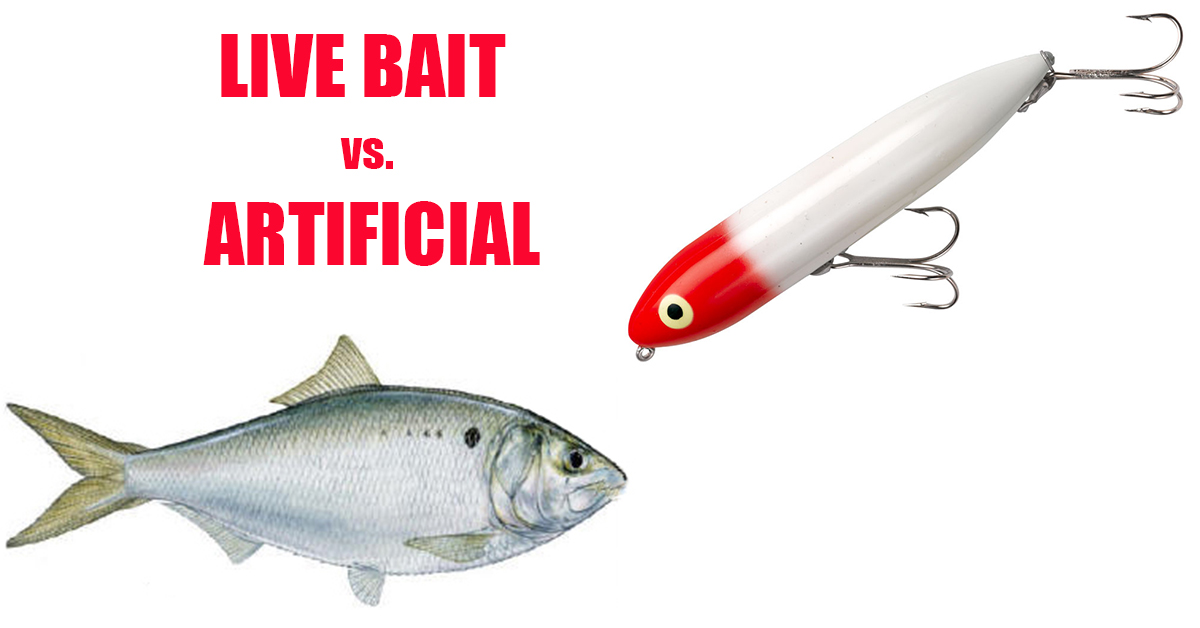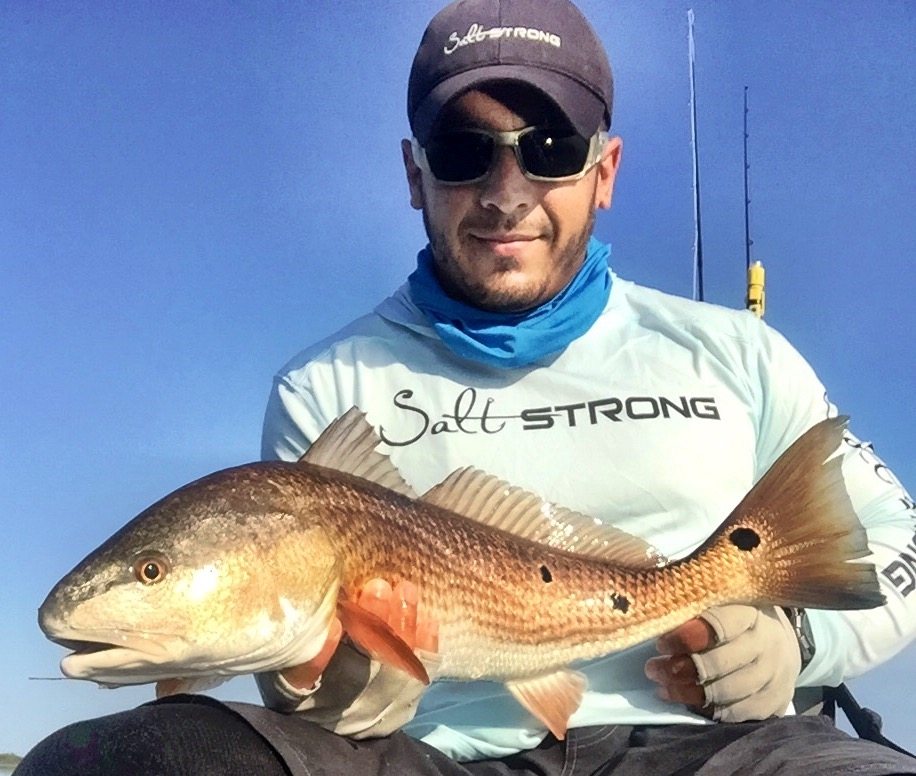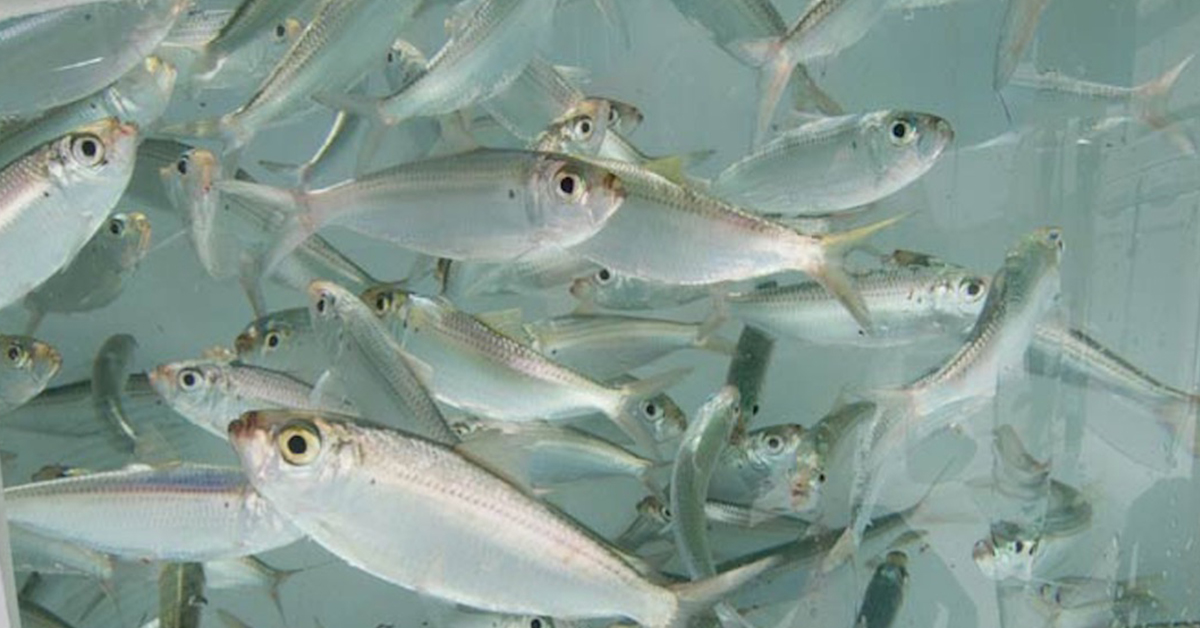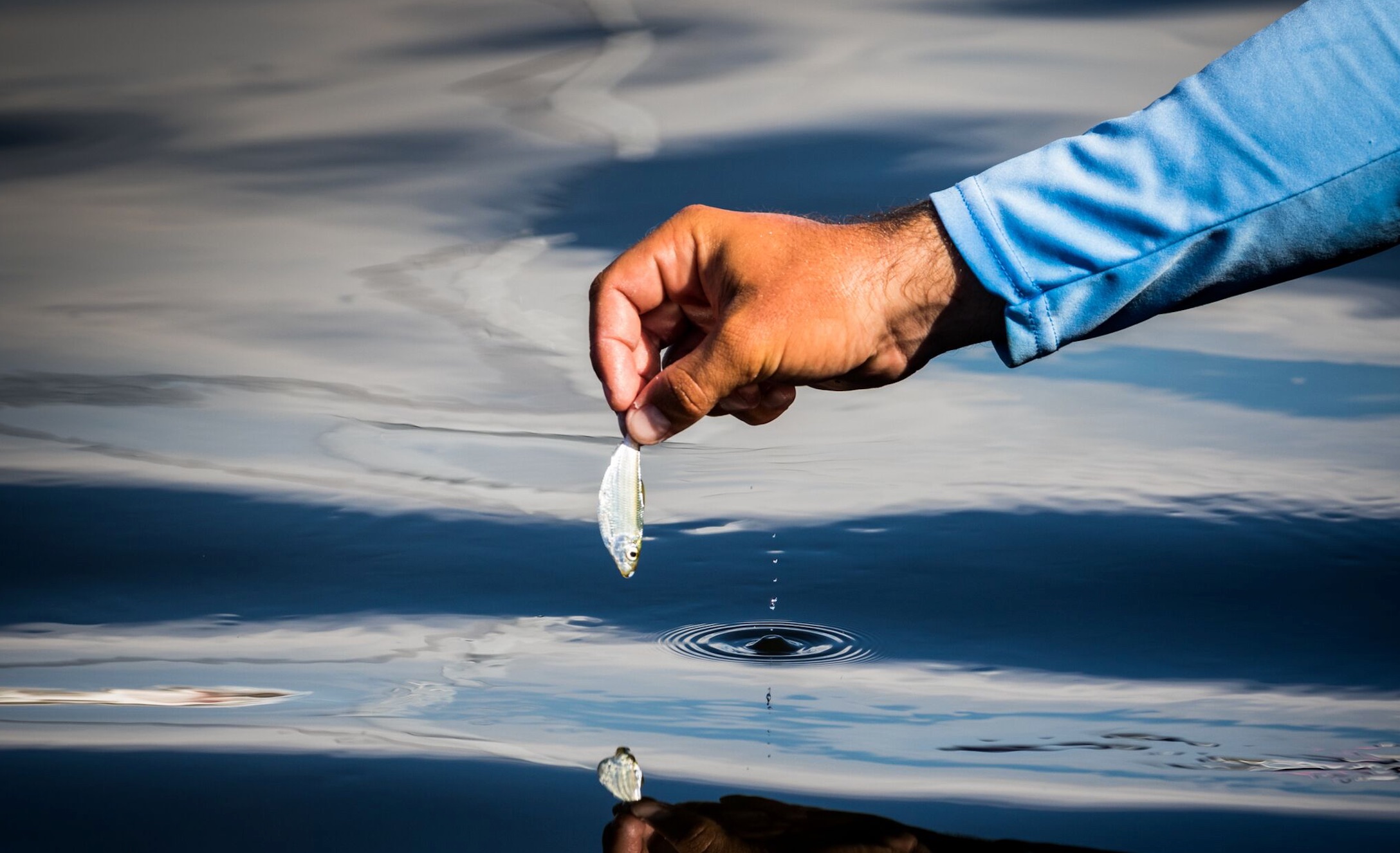Live Bait vs. Artificial: Which Fishing Technique Is Best For Inshore Fishing?
- By: Joseph Simonds
- on
- Found In: Fishing Tips

Serious question…
Which one is better?
- Live bait
OR….
- Artificial lures
Truth be told, the answer is more complicated than just picking your go-to option, or picking the option that caught you the biggest fish of your life, or by picking the one that your tackle store or fishing buddy recommends…
Here is some proof in point.
I recently asked a pretty well-known and well-respected fishing guide in Florida if he preferred live bait or artificial lures if he had to pick one for a tournament.
His answer kind of shocked me…

He told me that he would fish artificial lures all day long because he knows it outfishes live bait given enough time and covering enough territory.
My next question was, “Then why do you use live bait with all of your charter customers?”
His answer, “Because most of them have no business casting an artificial lure with four other people in the boat doing the same thing. Especially with some of the newer anglers… someone is destined to leave with a pierced body part that wasn’t pierced when they hopped on my boat…”
Makes sense.
But shortly after, a completely different well-known and well-respected fishing guide told me just the complete opposite thing. He said you he wouldn’t use artificial lures with his clients or for himself.
He was a live bait guy and proud of it.
Hmmm.
How can two amazing fishing guides be so far apart on this debate of live bait vs artificial bait? I guess it’s probably due to the same reason so many anglers (both saltwater and freshwater anglers) can’t agree on this.
So we decided to break down some of the important aspects to catching fish, compare each option side by side, and then see if we had a clear winner.
Let’s dig in.
Note: For this comparison, we consider live bait to also include dead, cut, or frozen bait that was once alive. Fly fishing flies and all plastic lures would fall in the artificial lures section.
Want to catch more Redfish, Snook, & Seatrout in less time WITHOUT having to use live bait?
Then click here now to learn more about the proven “Inshore Slammer” online fishing course.
Cost: Live Bait vs Artificial Lures

Live Bait:
Although most live baiters have the larger up-front cost of a cast net, a good net can last many years without needing to be replaced.
Of course, live bait anglers have the time value of money against them (as it takes time to catch live bait), this first particular comparison is strictly looking at dollars and cents.
On the other hand, if you are going to a tackle store, marina, or bait boat and buying live bait (whether it be live shrimp, pinfish, ballyhoo, frozen squid, etc) then you are most likely spending some serious bucks over the course of a few years.
Artificial Lures:
Let’s face it, regardless if you only stick to a handful of lures and become an expert using them (as is recommended in the Inshore Fishing Manifesto PDF), it is still likely you are going to buy countless packs of baits, hooks, etc. over the course of a year or two.
If you fish enough, you will lose artificial baits, you will have soft plastics ripped apart by junk fish, you’ll have hooks rust out, and an entire laundry list of other things that can cause you to replace your lures.
But what is even more probable is that you end up buying loads of the latest and greatest lures out there. Whether you see a commercial pitching a new lure, see the fishing pros on TV mention a new lure that they love, or have a friend recommend a new one, there is a reason that most artificial anglers have big tackle boxes…
The only good news is that artificial lures are more reusable than live bait, but it doesn’t mean they last forever…
Winner:
Live Bait if you do it yourself (throw a cast net), but Artificial lures when compared with buying live bait for every single fishing trip.
Size Of Fish Caught: Live Bait vs Artificial

Live Bait:
In general, if you want to catch consistent lunkers, monster mogans, and world record fish, you will need some live bait.
And if you asked fishing guides from either the freshwater or the saltwater world what they would use for bait if their only goal for the day was to catch as many monster fish as possible, it would be live bait.
From catching redfish to sharks in the saltwater, to walleye and bass in freshwater, live bait continues to produce some big fish.
Now there have been many trophy fish (and even many state and world record fish) caught from artificial lures, but by and large, your best chance in a given day to land the fish of your dreams would be with live bait.
Artificial Lures:
Artificial lures are amazing for catching all types of fish, both big and small.
Many inshore anglers would agree that if you were only trying to catch slot fish (like redfish for instance), an artificial lure might be your best bet. But if you entire goal was to land the biggest fish of the day, some sort of live bait would be the top choice for the majority of anglers (assuming it was easy to get live bait).
As you will see below in the “amount of fish caught” section, artificial lures have been known to outfish live bait in terms of total fish, but in general, they don’t match up to live bait if you are only targeting big fish.
Winner:
Live Bait
Amount Of Fish Caught: Live Bait vs Artificial

Live Bait:
Although most live bait anglers would like to tell you that they can catch both Bigger AND More fish using live bait than artificial, what many live baiters tend to leave out is the time it takes (on average) to get live bait.
For a fishing guide that is out on the water every single day, getting live bait is not that tough, and they knot exactly where to fish with the lively baits because they are on the water so often and have a good idea where the fish are holding.
But for a weekend warrior that doesn’t have his or her ear to the water every day, getting live bait can take some time… some days only an extra 20 minutes, while other days it eats up hours after it is all said and done.
And then when you factor in that you can’t cover as much ground when live baiting vs artificial lures, this one is going to be a tough one to win for the live baiters when you factor in the time aspect.
Artificial Lures:
Unlike live bait fishing, an angler using nothing but artificial lures can start fishing immediately, does not have to worry about finding bait, throwing a cast net, using sabiki rigs, or making sure the live well is working…
They can start catching fish right away, not to mention cover a whole lot more ground than someone fishing with live bait.
Regardless if you are beach fishing, fishing from a pier, or fishing from a boat, you will have more opportunities in front of fish while using artificial bait vs live bait.
All things being equal (skill of the angler, tides, location, etc), a solid angler using artificial lures should be able to catch more fish in a specified amount of time than using live bait. Of course, that doesn’t mean all of the fish will be keepers or the targeted species.
There was even a 4-year study in New Zealand that proved artificial lures caught more fish (but not as many trophy fish) when compared to live bait fishing.
Winner:
Artificial Lures
Conservation: Live Bait vs Artificial Lures

Live Bait:
This is certainly the most controversial comparison when it comes to live bait anglers vs artificial anglers.
It can be easily argued that one method may or may not be more conservation friendly, but there are some obvious points that we must point out about both methods.
To begin, no matter how much you love live bait fishing, it is pretty tough to argue that it can be considered good for the conservation of future fishing…
Why?
Well, with any kind of live bait fishing you must kill fish (or other sea life such as shrimp, squid, etc.) in order to catch fish. Now that’s not to say that live bait fishing is bad because there certainly doesn’t seem to be a shortage of baitfish, but it is still a fact that you have to purposely kill a fish in order to catch one.
I’ve seen anglers “black out” a livewell and go through (aka kill) countless dozens of bait fish and not bring home a single fish. On the other hand, I’ve seen anglers only have to use a couple of pinfish to bring home a couple of nice grouper that fed both of their families.
But either way you look at it, although live bait fishing has gone on for generations (and will surely continue to go on for generations), you can’t help but wonder how many more baitfish would be around if we didn’t kill so many of them in our pursuit to catch bigger fish.
Food for thought.
Want to catch more Redfish, Snook, & Seatrout in less time WITHOUT having to use live bait?
Then click here now to learn more about the proven “Inshore Slammer” online fishing course.
Artificial Lures:
Artificial lures don’t exactly fit the criteria for being conservation friendly due to all of the lures, plastic worms, plugs, and hooks that have been left out in the water over the years. Sometimes the left behind plastic is due to a break-off while fighting a fish (where there is nothing you can really do), while sometimes it is from a careless angler not picking up after himself or herself.
Either way, lures left out in our oceans, lakes, rivers, and streams don’t help out in terms of conservation.
The good news is that many plastic lure manufacturers are starting making their lures and soft plastics more biodegradable (like these biodegradable fishing lures), and even the hooks will eventually break apart and eventually disintegrate in the saltwater.
Overall, although artificial lures do occasionally make their way into the ocean, it’s not like it happens on every cast… and in some cases, anglers can go a year or longer without losing an individual lure.
Winner:
Too tough to declare a winner
Storage / Messiness: Live Bait vs. Artificial

Live Bait:
Let’s face it, if you plan on using live bait you can’t just leave the bait fish in a small pail of water on the boat and hope that they stay alive all day.
It’s the reason why there is an entire industry around live bait fishing! From cast nets, to pumps, to custom live well manufacturers, to bait buckets, there is an endless amount of different ways and methods to keep your bait alive.
Of course, all of this means that it will take up valuable real estate on your boat, dock, fishing cart, etc. What do a cast net, a bucket, a live well, a dip net, and a chum block all have one thing in common? They take up room!
Regarding the mess, if you are throwing a cast net over grass flats or on a day where there is a lot of weeds (and/or jellyfish) in the water, you know what kind of mess it can bring on your boat.
Finally, after a day of fishing with live bait, there is much more cleaning to do:
- Cleaning your cast net
- Cleaning your live well
- Cleaning the boat better from any debris the net brought in as an “after catch”
Artificial Lures:
Depending on the size of your tackle box, you will need at least that much room on your boat, kayak, back, etc. to store your lures.
I have found over time that I am better off simplifying my tackle box and only carrying a small soft tackle box worth of lures so I can fit everything in a really small area.
Unless you are doing offshore fishing for big game and need monster lures (and lots of them due to different colors and sizes for certain fish), most of us won’t have artificial lures taking up as much space as what live bait fishing requires.
And although there are some soft plastics that can make a mess if their juice spills (like Berkley Gulp Juice), artificial lures most often do not cause a mess.
Winner:
Artificial Lures
Skill Level: Live Bait vs Artificial Lures

Live Bait:
Remember the captain that I mentioned earlier that said he uses live bait because the majority of his customers “need to be using live bait?”
What he meant by that statement is that pretty much anyone can use live bait. If you are offshore fishing a wreck, even an absolute beginner can quickly be taught how to drop a live bait, squid, or shrimp down to the bottom and wait for a tug…
Same goes if you are inshore fishing with cut bait/live bait for monster red drum.
Same goes for sitting in a bass boat live baiting for lunker largemouth, on the bank of a lake live baiting for catfish, or on a pier using live shrimp to catch snapper and sheepshead.
If you can flip a bail, cast, and reel, you can do ok catching fishing with live bait.
Now certainly there is still a learning curve when you compare a beginner vs. a seasoned live bait angler, and it’s not to say that live bait is easy to be good at, but the point it that the skill level is pretty low to live bait.
Artificial Lures
Unless you are trolling while using artificial lures/plugs, you will need to have a little skill to work an artificial lure.
How you retrieve an artificial lure is the most critical part once you find fish. A sloppy retrieve can mean the difference between a strike and a spooked fish.
Yes, there are times when fish will hit just about anything, but to catch fish that aren’t in a feeding frenzy on an artificial lures takes some level of skill.
Things like casting a lure to an exact target spot, twitching a jig off the bottom correctly, working a topwater plug all take some skill and practice.
Thus, live baits takes the prize on this one as pretty much all levels of anglers can do it.
Winner:
Live Bait
Control: Live Bait vs Artificial Lures

Live Bait:
There are some great hooking tricks to help ensure your bait fish swims a certain way (like this “how to rig a pinfish video” shows), but no matter how hard you try, you don’t have full control of your live bait.
If you have spent enough time live bait fishing you know how many times your bait has found a way to mess up the presentation (from hooking itself to getting wrapped up in the line).
Not to mention, when a live bait sees a bigger fish coming, it is going to do everything in its power to get away. From hiding under rocks or other structure to swimming in circles with the weight or bobber dragging behind it.
Live bait might catch some monster fish, but you do lack control.
Artificial Lures:
With most artificial lures, you are in control of the presentation.
It’s one of the downsides of the ease of use in terms of skill level, but certainly, a plus when it comes to controlling what your targeted fish sees.
With artificial lures, you can slow it down or speed it up however you please.
Winner:
Artificial Lures
Conclusion

It’s no wonder the debate about live bait vs artificial has gone on for so long…
These two different methods of catching fish have both have so many pros.
For instance, if my goal was to catch the biggest fish possible for the day, I would most likely use live bait.
However, if I only had an hour to fish after work, I’d certainly go with artificial to get the most out of my time.
It’s basically too close to call. Both options have merit and we recommend that ALL anglers learn how to catch fish using both live bait and artificial lures to see which one fits you best.
What are you thoughts on artificial vs. live bait?
Let us know in the poll below.
Which one would you pick if you had to choose one?
Want to catch more Redfish, Snook, & Seatrout in less time WITHOUT having to use live bait?
Then click here now to learn more about the proven “Inshore Slammer” online fishing course.
Related categories:
STOP WASTING TIME ON THE WATER!
Do what the “SMART ANGLERS” are doing and join the Insider Club.
Here’s what you’ll receive today when you join:
- Weekly fishing reports and TRENDS revealing exactly where you should fish every trip
- Weekly “spot dissection” videos that walk you through all the best spots in your area
- Exclusive fishing tips from the PROS you can’t find anywhere else
- Everything you need to start catching fish more consistently (regardless if you fish out of a boat, kayak, or land).









Love live bait but you know ya can’t get live bait to move like my lures 😎
Thanks for the good article. I learned a lot of things i just wish i could find a answer for ,y search. So i hope you fall off the boat.
Something not mentioned: the ‘sport’ factor … if you are fishing for sport and you don’t keep your fish, artificials are definitely the way to go, the reason being that (as mentioned in the article) they require more skill to use. Take ice fishing, for example — what takes more skill? Setting a trap with a live smelt and just waiting and hoping the smelt moves in a way that triggers a bite or jigging a spoon in such a way that entices the fish to bite? I know what my answer is.
live bait can certainly catch more fish on a good day however artificial can catch a lot of fish in the right spot with the right lure.
If i want to practice casting I use artificial, if i want to catch fish i use live.
My dad loves fishing, and our whole family enjoys our boat trips together. His birthday is coming up, so I wanted to get him a really great present. I don’t know much about tackles or fishing techniques, so I appreciate the comparison between live bait and artificial. I really like the fact artificial lure last a lot longer than live bait.
Love this! I love catching monster reds on a blue crab, but also love the quick fight of a smaller inshore fish on artificial. The ease of artificial makes it better for me. Thanks for the article!
Good article Joe! I for one, am not very good at artificial presentation having used primarily live baits all my life. I do have a few arti baits that I can use but if I have a choice I’m using live. Shhh! Don’t tell anyone but my all time favorite bait is fresh dead ballyhoo, both inshore or offshore. But that’s just between you and me. Salt Stong!
Haha. Thanks for taking the time to read and comment Kendall! And nothing against live bait fishing at all. It certainly works!